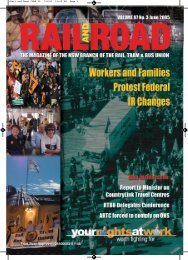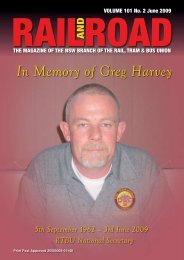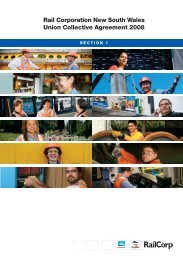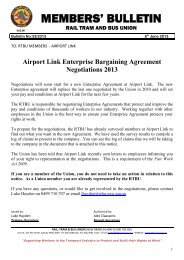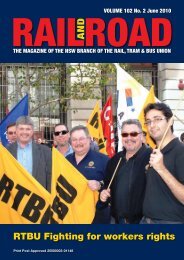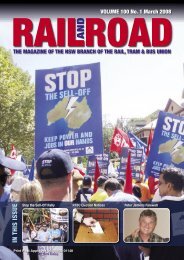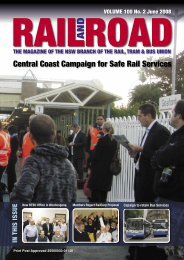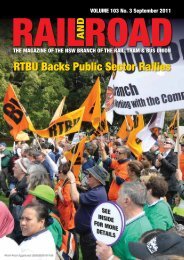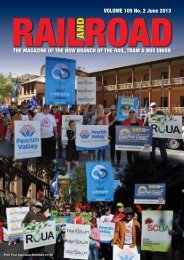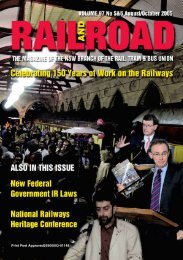Chapter 6: - Rail, Tram and Bus Union of NSW
Chapter 6: - Rail, Tram and Bus Union of NSW
Chapter 6: - Rail, Tram and Bus Union of NSW
Create successful ePaper yourself
Turn your PDF publications into a flip-book with our unique Google optimized e-Paper software.
*On Wooden <strong>Rail</strong>s <strong>Chapter</strong> 6 8/30/05 8:50 PM Page 209<br />
Tea Without Sympathy<br />
Women <strong>of</strong> the Triple R<br />
In their recent book, Haynes <strong>and</strong><br />
Hannah comment that very few stories<br />
collected were about women. ”There is<br />
a very good reason for this: for the first<br />
hundred years <strong>of</strong> its existence the<br />
railways employed very few women.<br />
Women didn’t become train drivers,<br />
firemen, guards or stationmasters until<br />
relatively recently”.<br />
“Even today with equal opportunity<br />
enshrined into our industrial awards,<br />
women still only make up a small<br />
proportion <strong>of</strong> the railway workforce. In<br />
<strong>NSW</strong> for example, there are 2770 train<br />
drivers <strong>and</strong> only thirty one <strong>of</strong> them are<br />
women. Of the 2070 track workers on the permanent<br />
way, only four are women.” 1<br />
Only in the area <strong>of</strong> station assistants <strong>and</strong> managers are<br />
there significant women workers (approximately 16% <strong>of</strong><br />
the workforce). While some <strong>of</strong> these claims, <strong>and</strong> mere<br />
focus on numbers <strong>of</strong> women employees is challenged<br />
elsewhere in this book, a celebrated area that was<br />
predominantly made up <strong>of</strong> women, was the <strong>Rail</strong>way<br />
Refreshment Rooms.<br />
The <strong>Rail</strong>way Refreshment Rooms (or Triple Rs) were<br />
both a worksite for thous<strong>and</strong>s <strong>of</strong> men <strong>and</strong> women on the<br />
railways, <strong>and</strong> <strong>of</strong>ten operated under very austere <strong>and</strong><br />
harsh conditions, but they were also a unique part <strong>of</strong> the<br />
long distance train traveller’s experience. The Triple Rs<br />
were an important public <strong>and</strong> social ambassador for the<br />
railways, employing a range <strong>of</strong> staff <strong>and</strong> spurning their<br />
own mini-industries <strong>of</strong> bakers, butchers, <strong>and</strong> others<br />
servicing the refreshment rooms on the stations.<br />
The fact that trains used steam power <strong>and</strong> need to be<br />
changed, watered <strong>and</strong> re-coaled, meant long delays at<br />
some stations, on what by modern st<strong>and</strong>ards were very<br />
long travel times. Thus, wherever there were main loco<br />
yards or junctions there were Triple Rs. In some places,<br />
passengers sat down to silver service three course meals<br />
in ornate dining rooms. Other stations just had fruit, pie<br />
<strong>and</strong> c<strong>of</strong>fee stalls called ‘tearooms’. The railway pie was<br />
the fast food <strong>of</strong> the steam era.<br />
On Wooden <strong>Rail</strong>s - Celebrating 150 Years <strong>of</strong> Work on the <strong>NSW</strong> <strong>Rail</strong>ways<br />
RRR Staff, C<strong>of</strong>fs Harbour, 1947<br />
Early accounts <strong>of</strong> a ‘rest room’ at Sydney Terminal were<br />
said to be via the supply <strong>of</strong> pastries by a Mrs Moon.<br />
Haynes <strong>and</strong> Hannah quote the <strong>of</strong>ficial Departmental<br />
History <strong>of</strong> 1955 to support this quaint claim:<br />
“The first refreshment room [at Sydney Terminal]<br />
consisted <strong>of</strong> a counter <strong>and</strong> two stools. It was open only<br />
shortly before the departure <strong>and</strong> arrival <strong>of</strong> trains.<br />
Supplies were brought to the station by a kind old lady<br />
from her pastry cook shop in Botany Road. It was quite<br />
common to see hungry passengers anxiously looking out<br />
for Mrs Moon <strong>and</strong> her basket when she was a little later<br />
than usual.” 2<br />
The first refreshment facility, however, seems to be the<br />
claim <strong>of</strong> Mr Henry Dudley, who applied to the railway<br />
manager in 1855 to rent a room for the provision <strong>of</strong><br />
refreshments. Finally, in 1856 he was leased a room for<br />
two pounds a week. His wife was also employed at<br />
Sydney station as a ladies’ waiting room attendant. At<br />
that stage, stoves were not allowed on the railway<br />
premises, making it difficult to provide hot<br />
refreshments. Dudley tried to get around this obstacle by<br />
erecting a tent on grounds near the station. His tent had<br />
twice caught fire from sparks from passing engines, <strong>and</strong><br />
in 1857 nearly blew over in strong winds. He ab<strong>and</strong>oned<br />
the venture in 1859. 3<br />
1Jim Haynes & Russell Hannah, All Aboard! Tales <strong>of</strong> the Australian <strong>Rail</strong>ways, ABC Books, Sydney, 2004, p 232<br />
2Ibid, p 235. In the tradition <strong>of</strong> populist histories, the authors didn’t bother to trouble their readers with details <strong>of</strong> the reference<br />
they cite.<br />
3See Andrew Messner, Train Up ! <strong>Rail</strong>way Refreshment Rooms in New South Wales, ARM Management, Sydney, 2003, Pp 7-9<br />
<strong>Chapter</strong> 6 - No Place for a Woman 209





